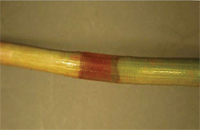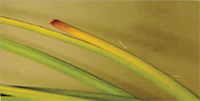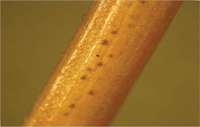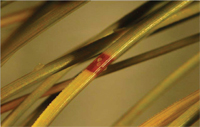Integrated Pest Management
Dothistroma Needle Blight
 The red banding symptoms observed on infected needles is the most distinctive symptom of this disease.
The red banding symptoms observed on infected needles is the most distinctive symptom of this disease.
 Needles will die back to the lesion and break off, leaving a gray or ashy appearance on the needle tips.
Needles will die back to the lesion and break off, leaving a gray or ashy appearance on the needle tips.
 Stromata under the epidermis of the needle that will emerge soon, dispersing spores for new infections.
Stromata under the epidermis of the needle that will emerge soon, dispersing spores for new infections.
 Needles may produce resin, or sap, as a defense mechanism to inhibit fungal growth.
Needles may produce resin, or sap, as a defense mechanism to inhibit fungal growth.
Dothistroma needle blight is a fungal disease that occurs on a variety of coniferous trees. It is also know as "red band" disease in the western United States. This banding symptom is due to the accumulation of toxins produced by the fungus. Symptoms of this disease can be very similar to another pine disease, brown spot needle blight.
HOSTS
- Austrian pine
- Ponderosa pine
- Other coniferous trees
SYMPTOMS
Symptoms of Dothistroma blight are very similar to another pine disease, brown spot needle blight, which is also caused by a Mycosphaerella fungal species. Symptoms may appear as:
- Slowed growth
- Severe defoliation
- Small yellow, tan, brown, or red lesions
- Premature needle drop
- Small black fungal structures called stromata will break through the outside of the dead parts of the needle, either singly or in groups
DISEASE CYCLE
Dothistroma needle blight most often has only one disease cycle each year, although secondary cycles can occur in areas with a mild, moist climate. First-year needles are typically infected beginning of mid-summer. Second-year needles and older needles can become infected from May to October. After the first year the disease has occurred, lesions in all stages of development and sporulation can be found throughout the growing season. The interval from infection to when symptoms appear can vary from 4 weeks to 6 months, depending on environmental conditions and hosts. It is typically shorter in the spring and longer in the winter. Stromata will mature and begin producing spores in the spring. The spores are exposed as the stromata push through the outer layer of the needle, rupturing it. They then disperse and start infectioning other trees.
DIAGNOSIS
To be sure that Dothistroma needle blight is the problem in your tree, they can be sampled and checked for the the fungus. Local county Extension agents may be able to do this for you. If confirmation is desired, the sample may be sent to the diagnostic lab. To do this, collect several branches exhibiting symptoms of infection. Plant tissues should be sealed in a plastic bag and sent to: Utah Plant Diagnostic Lab, Department of Biology, 5305 Old Main Hill, Logan, UT 84322. Care should be taken not to expose the bag to excessive heat or cold so that the specimen and pathogen remain alive until the sample is received. General instructions for sample collection and shipment can be found at: http://utahpests.usu.edu/uppdl/submission-form and directing your browser to the diagnostic laboratory sample submission information.
RESISTANT VARIETIES
There are no species of pine that are completely resistant and resistance will vary greatly among the same species. One proposed mechanism of resistance involves the plant inhibiting fungal growth by producing fatty acids and resin, or sap, on the surface of needles. As a result, infected needles may produce a lot of sap in response to the infection. Some seed from Austrian and ponderosa pines have been found that have a useful degree of resistance and have been used for plantings in the Great Plains.
MANAGEMENT
There are some cultural methods that can be used to lessen disease severity. The disease is typically worse in the lower crown area of the tree where air circulations is poor. Pruning the lower branches and spacing trees will increase air circulation and can reduce disease severity. Clean up and dispose of any debris from around the infected trees, including dead needles and fallen limbs.
In some cases, managing Dothistroma needle blight with chemicals has proven feasible. Although there haven't been any studies in the west, in the central United States two applications of copper fungicides have prevented infection of needles. As with other diseases, ultimate control will be achieved through the use of resistant trees.

